英文科技论文的写作方法
- 格式:ppt
- 大小:37.50 KB
- 文档页数:15
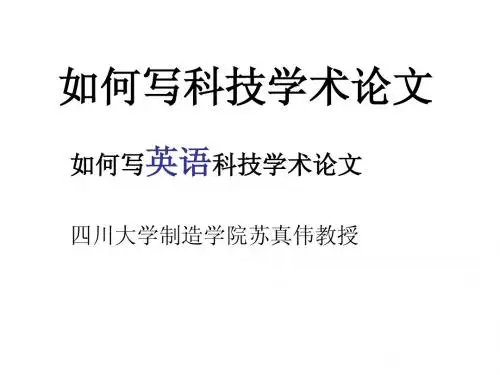
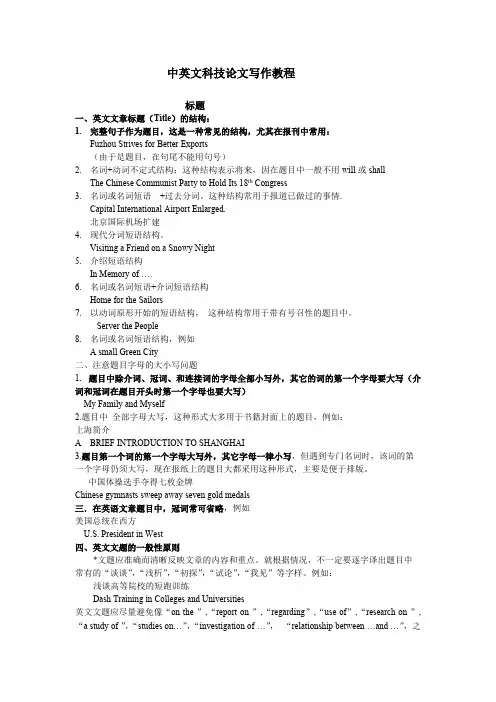
中英文科技论文写作教程标题一、英文文章标题(Title)的结构:1.完整句子作为题目,这是一种常见的结构,尤其在报刊中常用:Fuzhou Strives for Better Exports(由于是题目,在句尾不能用句号)2.名词+动词不定式结构:这种结构表示将来,因在题目中一般不用will或shallThe Chinese Communist Party to Hold Its 18th Congress3.名词或名词短语+过去分词。
这种结构常用于报道已做过的事情.Capital International Airport Enlarged.北京国际机场扩建4.现代分词短语结构。
Visiting a Friend on a Snowy Night5.介绍短语结构In Memory of ….6.名词或名词短语+介词短语结构Home for the Sailors7.以动词原形开始的短语结构,这种结构常用于带有号召性的题目中。
Server the People8.名词或名词短语结构,例如A small Green City二、注意题目字母的大小写问题1. 题目中除介词、冠词、和连接词的字母全部小写外,其它的词的第一个字母要大写(介词和冠词在题目开头时第一个字母也要大写)My Family and Myself2.题目中全部字母大写,这种形式大多用于书籍封面上的题目,例如:上海简介A BRIEF INTRODUCTION TO SHANGHAI3.题目第一个词的第一个字母大写外,其它字母一律小写,但遇到专门名词时,该词的第一个字母仍须大写,现在报纸上的题目大都采用这种形式,主要是便于排版。
中国体操选手夺得七枚金牌Chinese gymnasts sweep away seven gold medals三.在英语文章题目中,冠词常可省略,例如美国总统在西方U.S. President in West四、英文文题的一般性原则*文题应准确而清晰反映文章的内容和重点。
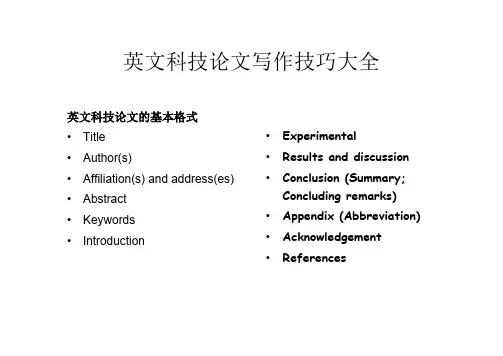
英文科技论文写作技巧大全英文科技论文的基本格式•Title•Author(s)•Affiliation(s) and address(es) •Abstract•Keywords•Introduction •Experimental •Results and discussion •Conclusion (Summary;Concluding remarks) •Appendix (Abbreviation)•Acknowledgement •References2.基本要求(1)Title长短适中,概括性强,重点突出,一目了然。
(2)Author(s)姓氏和名字要容易弄清楚,以免发生以名代姓。
(3)Affiliation(s) and address(es)准确清楚,使读者能按所列信息顺利地与作者联系。
(4)Abstract不宜太详尽,也不宜太简短,应将论文的研究体系、主要方法、重要发现、主要结论等,简明扼要地加以概括。
不要将结论与提要重复使用。
(5)Introduction说明本研究的目的意义。
归纳与本研究密切相关的前人研究结果及有关文献,指出本研究与前人研究的不同之处。
说明本论文要解决的问题及方法、手段等。
不宜将本论文的结果在“绪论”中叙述。
(6)Experimental叙述主要的实验过程、方法、仪器设备、试剂来源及规格等。
不宜将实验结果在“实验部分”中叙述。
(7)Results and discussion是论文的核心部分,要求:–数据及图表的内容及含义交代清楚,有条理;–对数据及现象的归纳、演绎、解释、立论要有逻辑性、自洽性。
–语句要准确、流畅、多样化,不宜重复使用相同的句型和词汇。
(8)Conclusion (Summary, Concluding remarks)简明扼要地归纳出本论文的新发现、新观点、新理论等。
不宜将“结果及讨论”部分的语句直接抄录作为结论。
(9)References要按所投杂志规定的格式准确书写。

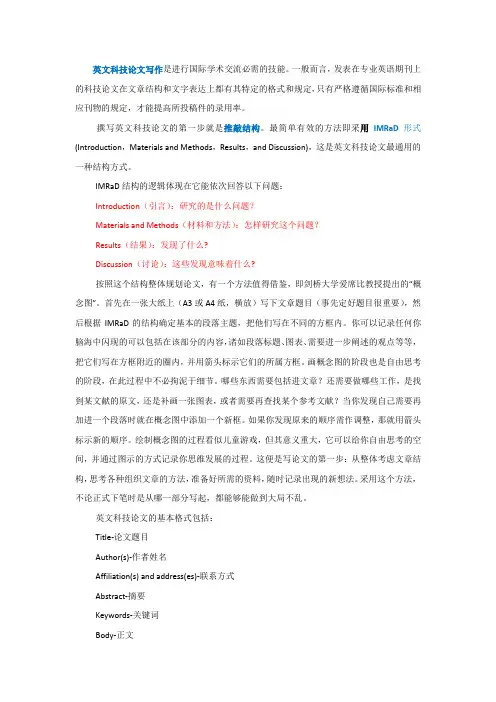
英文科技论文写作是进行国际学术交流必需的技能。
一般而言,发表在专业英语期刊上的科技论文在文章结构和文字表达上都有其特定的格式和规定,只有严格遵循国际标准和相应刊物的规定,才能提高所投稿件的录用率。
撰写英文科技论文的第一步就是推敲结构。
最简单有效的方法即采用IMRaD形式(Introduction,Materials and Methods,Results,and Discussion),这是英文科技论文最通用的一种结构方式。
IMRaD结构的逻辑体现在它能依次回答以下问题:Introduction(引言):研究的是什么问题?Materials and Methods(材料和方法):怎样研究这个问题?Results(结果):发现了什么?Discussion(讨论):这些发现意味着什么?按照这个结构整体规划论文,有一个方法值得借鉴,即剑桥大学爱席比教授提出的“概念图”。
首先在一张大纸上(A3或A4纸,横放)写下文章题目(事先定好题目很重要),然后根据IMRaD的结构确定基本的段落主题,把他们写在不同的方框内。
你可以记录任何你脑海中闪现的可以包括在该部分的内容,诸如段落标题、图表、需要进一步阐述的观点等等,把它们写在方框附近的圈内,并用箭头标示它们的所属方框。
画概念图的阶段也是自由思考的阶段,在此过程中不必拘泥于细节。
哪些东西需要包括进文章?还需要做哪些工作,是找到某文献的原文,还是补画一张图表,或者需要再查找某个参考文献?当你发现自己需要再加进一个段落时就在概念图中添加一个新框。
如果你发现原来的顺序需作调整,那就用箭头标示新的顺序。
绘制概念图的过程看似儿童游戏,但其意义重大,它可以给你自由思考的空间,并通过图示的方式记录你思维发展的过程。
这便是写论文的第一步:从整体考虑文章结构,思考各种组织文章的方法,准备好所需的资料,随时记录出现的新想法。
采用这个方法,不论正式下笔时是从哪一部分写起,都能够能做到大局不乱。
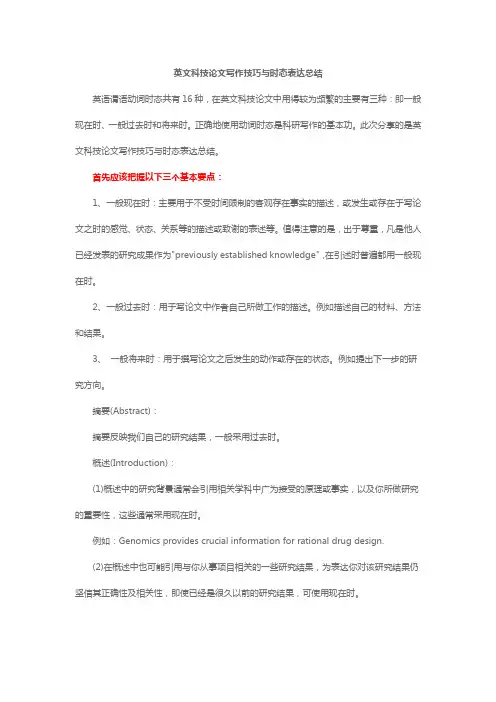
英文科技论文写作技巧与时态表达总结英语谓语动词时态共有16种,在英文科技论文中用得较为频繁的主要有三种:即一般现在时、一般过去时和将来时。
正确地使用动词时态是科研写作的基本功。
此次分享的是英文科技论文写作技巧与时态表达总结。
首先应该把握以下三个基本要点:1、一般现在时:主要用于不受时间限制的客观存在事实的描述,或发生或存在于写论文之时的感觉、状态、关系等的描述或致谢的表述等。
值得注意的是,出于尊重,凡是他人已经发表的研究成果作为"previously established knowledge",在引述时普遍都用一般现在时。
2、一般过去时:用于写论文中作者自己所做工作的描述。
例如描述自己的材料、方法和结果。
3、一般将来时:用于撰写论文之后发生的动作或存在的状态。
例如提出下一步的研究方向。
摘要(Abstract):摘要反映我们自己的研究结果,一般采用过去时。
概述(Introduction):(1)概述中的研究背景通常会引用相关学科中广为接受的原理或事实,以及你所做研究的重要性,这些通常采用现在时。
例如:Genomics provides crucial information for rational drug design.(2)在概述中也可能引用与你从事项目相关的一些研究结果,为表达你对该研究结果仍坚信其正确性及相关性,即使已经是很久以前的研究结果,可使用现在时。
例如:Many of the lakes and wetlands in the region are located in craters or valleys blocked by early Pliocene lava flows (Ollier & Joyce, 1964).Garcia (1993) suggested that under certain conditions, an individual’s deposit income is the same as the income from purchased national debt, thus changes in the amount of bank loans and deposits caused by changes in the amount of reserves will eventually affect the bond price.需要注意的是如果引用的是一些已经过时或失效的科研结果,动词要使用过去时。
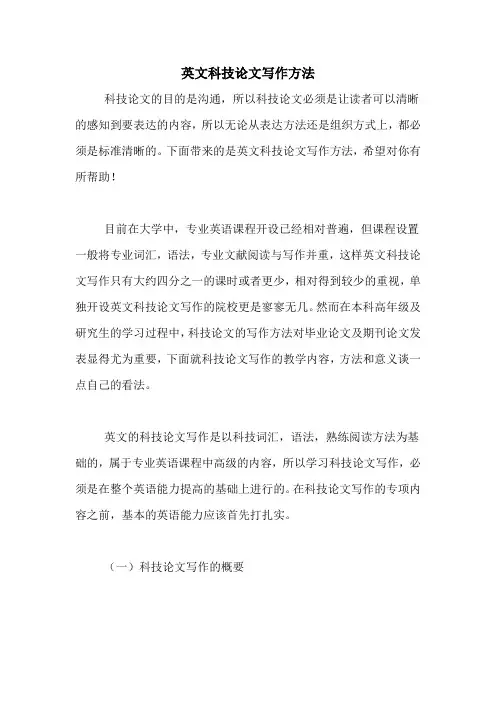
英文科技论文写作方法科技论文的目的是沟通,所以科技论文必须是让读者可以清晰的感知到要表达的内容,所以无论从表达方法还是组织方式上,都必须是标准清晰的。
下面带来的是英文科技论文写作方法,希望对你有所帮助!目前在大学中,专业英语课程开设已经相对普遍,但课程设置一般将专业词汇,语法,专业文献阅读与写作并重,这样英文科技论文写作只有大约四分之一的课时或者更少,相对得到较少的重视,单独开设英文科技论文写作的院校更是寥寥无几。
然而在本科高年级及研究生的学习过程中,科技论文的写作方法对毕业论文及期刊论文发表显得尤为重要,下面就科技论文写作的教学内容,方法和意义谈一点自己的看法。
英文的科技论文写作是以科技词汇,语法,熟练阅读方法为基础的,属于专业英语课程中高级的内容,所以学习科技论文写作,必须是在整个英语能力提高的基础上进行的。
在科技论文写作的专项内容之前,基本的英语能力应该首先打扎实。
(一)科技论文写作的概要科技论文写作是科研工作者的必修课,科学研究工作中,沟通主要是靠科技论文,所以科研人员学术水平的衡量标准在很大程度上是他论文的发表情况。
科技论文不能不得到重视,科技论文不像其它文章的写作,不需要过多修饰,只需要严谨和清晰,要简洁无累述。
从古时起,人类便通过各种文字符号作为沟通的主要手段,这便成为科学与文明的主要传载者,也是科技论文发展的前身。
当今,科技论文写作即是以规范的形式,通过规范的审核及流程,正规发表在期刊上的过程。
所谓正规发表即是,有可以被评估的原始资料,可以被重复的实验过程,可以被评估的推导过程。
(二)科技论文各项内容的写作要点科技论文写作应该分为:标题,摘要,引言,正文,结论,讨论和 __几大部分。
科技论文的标题位于第一行正中,不用加标点,常用动名词的短语代替完整的句子。
如有要加副标题,用冒号隔开。
作者的姓名和地址写在标题的正下方,中 __姓名和地名均按照汉语排序用汉语拼写书写即可。
摘要是全文的高度概括,使读者可以通过它迅速了解全文。

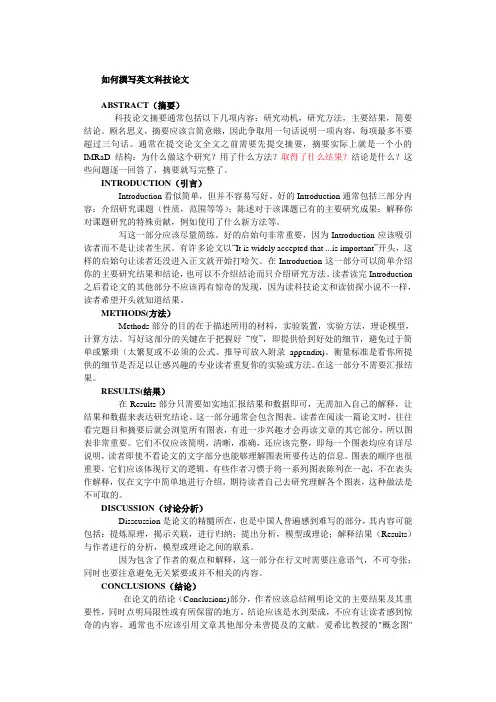
如何撰写英文科技论文ABSTRACT(摘要)科技论文摘要通常包括以下几项内容:研究动机,研究方法,主要结果,简要结论。
顾名思义,摘要应该言简意赅,因此争取用一句话说明一项内容,每项最多不要超过三句话。
通常在提交论文全文之前需要先提交摘要,摘要实际上就是一个小的IMRaD结构:为什么做这个研究?用了什么方法?取得了什么结果?结论是什么?这些问题逐一回答了,摘要就写完整了。
INTRODUCTION(引言)Introduction看似简单,但并不容易写好。
好的Introduction通常包括三部分内容:介绍研究课题(性质,范围等等);陈述对于该课题已有的主要研究成果;解释你对课题研究的特殊贡献,例如使用了什么新方法等。
写这一部分应该尽量简练。
好的启始句非常重要,因为Introduction应该吸引读者而不是让读者生厌。
有许多论文以“It is widely accepted that ...is important”开头,这样的启始句让读者还没进入正文就开始打哈欠。
在Introduction这一部分可以简单介绍你的主要研究结果和结论,也可以不介绍结论而只介绍研究方法。
读者读完Introduction 之后看论文的其他部分不应该再有惊奇的发现,因为读科技论文和读侦探小说不一样,读者希望开头就知道结果。
METHODS(方法)Methods部分的目的在于描述所用的材料,实验装置,实验方法,理论模型,计算方法。
写好这部分的关键在于把握好“度”,即提供恰到好处的细节,避免过于简单或繁琐(太繁复或不必须的公式、推导可放入附录appendix)。
衡量标准是看你所提供的细节是否足以让感兴趣的专业读者重复你的实验或方法。
在这一部分不需要汇报结果。
RESULTS(结果)在Results部分只需要如实地汇报结果和数据即可,无需加入自己的解释,让结果和数据来表达研究结论。
这一部分通常会包含图表。
读者在阅读一篇论文时,往往看完题目和摘要后就会浏览所有图表,有进一步兴趣才会再读文章的其它部分,所以图表非常重要。
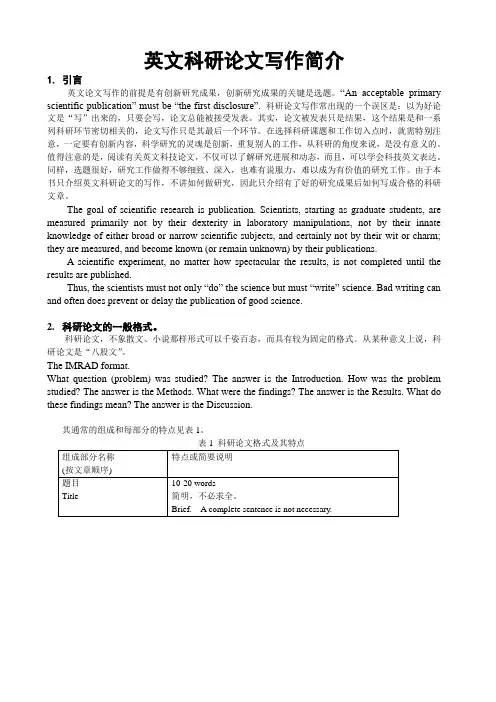
英文科研论文写作简介1. 引言英文论文写作的前提是有创新研究成果,创新研究成果的关键是选题。
“An acceptable primary scientific publication” must be “the first disclosure”.科研论文写作常出现的一个误区是:以为好论文是“写”出来的,只要会写,论文总能被接受发表。
其实,论文被发表只是结果,这个结果是和一系列科研环节密切相关的,论文写作只是其最后一个环节。
在选择科研课题和工作切入点时,就需特别注意,一定要有创新内容,科学研究的灵魂是创新,重复别人的工作,从科研的角度来说,是没有意义的。
值得注意的是,阅读有关英文科技论文,不仅可以了解研究进展和动态,而且,可以学会科技英文表达。
同样,选题很好,研究工作做得不够细致、深入,也难有说服力,难以成为有价值的研究工作。
由于本书只介绍英文科研论文的写作,不讲如何做研究,因此只介绍有了好的研究成果后如何写成合格的科研文章。
The goal of scientific research is publication. Scientists, starting as graduate students, are measured primarily not by their dexterity in laboratory manipulations, not by their innate knowledge of either broad or narrow scientific subjects, and certainly not by their wit or charm; they are measured, and become known (or remain unknown) by their publications.A scientific experiment, no matter how spectacular the results, is not completed until the results are published.Thus, the scientists must not only “do” the science but must “write” science. Bad writing can and often does prevent or delay the publication of good science.2.科研论文的一般格式。
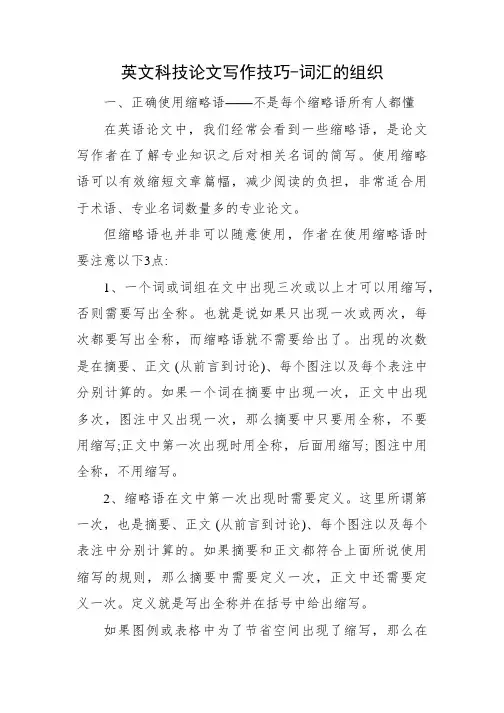
英文科技论文写作技巧-词汇的组织一、正确使用缩略语——不是每个缩略语所有人都懂在英语论文中,我们经常会看到一些缩略语,是论文写作者在了解专业知识之后对相关名词的简写。
使用缩略语可以有效缩短文章篇幅,减少阅读的负担,非常适合用于术语、专业名词数量多的专业论文。
但缩略语也并非可以随意使用,作者在使用缩略语时要注意以下3点:1、一个词或词组在文中出现三次或以上才可以用缩写,否则需要写出全称。
也就是说如果只出现一次或两次,每次都要写出全称,而缩略语就不需要给出了。
出现的次数是在摘要、正文 (从前言到讨论)、每个图注以及每个表注中分别计算的。
如果一个词在摘要中出现一次,正文中出现多次,图注中又出现一次,那么摘要中只要用全称,不要用缩写;正文中第一次出现时用全称,后面用缩写; 图注中用全称,不用缩写。
2、缩略语在文中第一次出现时需要定义。
这里所谓第一次,也是摘要、正文 (从前言到讨论)、每个图注以及每个表注中分别计算的。
如果摘要和正文都符合上面所说使用缩写的规则,那么摘要中需要定义一次,正文中还需要定义一次。
定义就是写出全称并在括号中给出缩写。
如果图例或表格中为了节省空间出现了缩写,那么在图注或表注中要解释缩写。
写全称时一般是全部用小写,除非是人名、地名等专有名词,而缩写一般是全大写,除非是约定俗成的写法,比如用 ChIP 代表 chromatin immunoprecipitation。
虽然有时候我们可能觉得某个缩写是论文所在领域非常普遍使用的,没有必要定义,可是还是应该考虑到也许有其他领域或者新进入这门领域的读者会阅读这篇论文,所以期刊都规定缩略语要先定义再使用。
确实有不需要定义就可以使用的缩略语,比如DNA,RNA,mRNA 在生物医学领域的文章中就不需要定义,标准单位写在数字之后(2 kg,5 mL)也不需要定义。
但是这种所谓的标准缩略语并不多,如果不能确定还是在第一次出现时给出全称比较好,例如用miR 代替microRNA 还是需要定义的。
只要发英文文章,就要遵循规则,不会写或者写不好不是抄的理由。
在英美体系中,作者写的东西属于创作,是不能剽窃的。
除非只想混文凭而已。
若搞科研,不从最初提高自己,遵循科研的规则,则百害无益。
一些常见的英文文章语言技巧1如何指出当前研究的不足以及有目的地引导出自己的研究的重要性通常在叙述了前人成果之后,用However来引导不足,比如:However, little information..little attention...little work...little datalittle researchor few studiesfew investigations...few researchers...few attempts...or nonone of these studieshas (have) been lessdone on ...focused onattempted toconductedinvestigatedstudied(with respect to)Previous research (studies, records) has (have)failed to considerignoredmisinterpretedneglected tooverestimated, underestimatedmisleadedthus, these previus results areinconclisive, misleading, unsatisfactory, questionable, controversial..Uncertainties (discrepancies) still exist ...这种引导之后一般会提出一种新方法,或者一种新方向。
如果研究的方法以及方向和前人一样,可以通过下面的方式强调自己工作的作用:However, data is still scarcerareless accuratethere is still dearth ofWe need toaim tohave toprovide more documentsdatarecordsstudiesincrease the datasetFurther studies are still necessary...essential...为了强调自己研究内容的重要性,一般还要在However之前介绍自己研究问题的反方面,另一方面等等。
sci论文英文写作技巧!SCI论文对作者的英语水平要求非常高,一篇语言不够好的论文,即使内容再好也会被拒。
因此,作者在撰写SCI论文时,应以英文思维方式写作,注意中西语言表达的差异。
此外,请特别注意以下环节。
一、写作时态英语中谓语动词有16种时态,在英文科技论文中使用较多的主要有3种:一般现在时、一般过去时和将来时。
正确使用动词时态是科技写作的基本功,我们在写英文论文的时候,如果不能正确选择时态,往往会改变文章的意思,影响审稿人和读者的理解。
如何在科技论文中正确使用时态,首先要掌握以下三个基本要点:1.一般现在时:主要用于描述不受时间限制的客观事实,或描述撰写论文时发生或存在的感受、状态、关系等,或表达感谢等。
值得注意的是,出于尊重,凡是他人发表的研究成果在引用时一般使用一般现在时。
2.一般过去时:用于描述作者在论文中所做的工作。
例如,描述你的材料、方法和结果。
3.一般将来时:用于表示写完论文后的动作或存在状态。
比如提出下一步的研究方向。
二、写作语态在科技论文摘要的翻译中,最常用的语态是被动语态。
与主动语态相比,被动语态在科技文摘翻译中具有以下优势:1.科技论文往往需要介绍不以人的意志为转移的客观研究过程和实验结果,使用被动语态更能突出科学研究的客观性。
2.使用被动形式还可以避免提及动作的执行者,从而使动作的研究更具普遍性。
3.由于被动语态的特殊结构,在调整句式结构方面具有更大的灵活性,在增加词组结构、扩展句式信息的同时,有利于保持句式结构的平衡和整齐。
三、SCI论文中最有可能出现的词SCI论文并不要求论文满满的文采,关键是把作者的意思表达清楚,让别人看得懂。
SCI论文中经常出现的词包括动名词和动词,还有现在分词、不定冠词、代词、副词、介词等。
因此,大面用词与其他写法没有太大区别。
但是由于学术论文的学术风格,论文中用词非常正式。
在写作过程中,don’t、can’t及won’t等字眼是很忌讳的。
另外,由于中国人的写作习惯,很多作者经常会出现and so worth及and so on等等,这些词在写英文论文的时候是非常忌讳的。
2. Contents1). paper writing: title, author/affiliation(从属关系), keywords, abstracts, introduction, main body, discussion, conclusion, acknowledgments, appendices(附件), [əˈpɛndɪˌsiz] references, etc.2). strategies of paper publication3). other related informationGeneral description of academic paper writing(学术论文的总则)1. Types of academic papers1). Academic report 学术报告Definition(定义):displaying the results of an experiment, investigation or inquiry (may not give personal opinions, evaluations on the issue).structure:IMRAD(论文主体):导言、材料、结果及讨论introduction, methods, results and discussion.2). Research paper 研究论文definition:comparatively narrow subject(相对具体的主题,题目切记宽泛);reporting empirical or theoretical work(实验或理论工作)in an academic field;usually published in academic journals;containing original research results;reviewing existing studies.structure:title, author/affiliation, abstracts, keywords, introduction, theoretical analysis or experimental description, results and discussion, conclusion, acknowledgments, references, appendices, etc.3). Course paper 课程论文definition:written by undergraduate or postgraduate students(本科生或研究生).written in line with the course requirements (符合课程要求)structure:decided under the instruction of the course tutor.4). Thesis/ Dissertation 学位论文definition:submitted in support of a candidate for a degree;presenting a proposition to argue against or defend;exercising judgment, argument, logic etc.structure:acknowledgements(鸣谢), abstract, introduction, literature review, methodology, data collection and analysis, findings and conclusions, suggestions for future work, etc.3. The style of academic writing 语体formal language(正式用语):concise, concrete(具体), objective(客观), logical(合理), coherent(连贯).1). person: the writer, we, etc2). V oice(语态): passive(被动)3). structure: nominal structure(名词结构)4). specialized vocabulary(专业词汇)4. General structure of an academic papertitleabstractskeywordsIntroductionliterature reviewresearch methodologies and proceduresresults and findingsdiscussionconclusionreferences※I. TitleGeneral functions1. summarizing2. attracting readers3. facilitating retrieval (便于检索)Linguistic features(语言特征)1. phrase instead of sentence用短语代替句子2. nouns and gerunds名词和动名词Writing requirements1. brief and conciseno more than 20 words, 8-12 on average subtitle is advisable if it’s long2. specific具体3. avoid questions不要用疑问句4. unified grammatically symmetrical, nouns and gerunds not mixed名词动名词不要混用5. Standard: abbreviations(缩略语), symbols(符号), terms(术语), capitalization(大写)e.g. 1). LEARNING FOREIGN LANGUAGES AND TEACHING CULTUREALBACKGROUND.2). Learning Foreign Languages and Teaching Cultural Background3). Learning foreign languages and teaching cultural background※II. Author/AffiliationGeneral functions1. Bearing author’s responsibility2. facilitating retrieval and correspondence便于检索和通信3. heightening academic level for valuing the academic levels of a researcher or anacademic institutionLinguistic featuresZhang Xing Chen Xinwu Ouyang HaiZHANG Xing CHEN Xinwu OUY ANG HaiZHANG, Xing Chen, Xinwu Ouyang, Hai Writing requirements1. format: the requirements of the journal2. number of authors: if more than 5, use “et al.”3. author’s title omitted4. address: from smaller units to larger onesWang ShuhuaSchool of Journalism and transmissionNorthwest UniversityXi’an, Shaanxi 710069P.R. China※III. KeywordsGeneral functions1. highlighting the theme2. retrieval便于检索Linguistic features1. more nouns2. limited numbers: 4-6 words on averageWriting requirements1. using the required section title:e.g. Keywords/Keywords Index/Keywords and Phrases/Indexing Terms, etc.2. placing the section correctly:below the abstract3. spacing the Keywords关键词之间的间隔:Comma(逗号), semicolon(分号), larger space(空格), no full stop at the end(结尾不要句号).4. adopting standard abbreviations采用标准的缩略形式※IV. AbstractI. Definition:An abstract is a succinct (sək’sɪŋkt)简洁summary of a piece of work, usually academic in nature.A self-contained (独立的)entity;tool in searching for information.II. Basic elements:backgroundtopicapproach three core elementsconclusionsignificanceIII. Category1. Descriptive abstract(说明性摘要): tells in an all around way what thepaper contains, including background, topic, approach,conclusion and significance.2. Informational abstract(信息性摘要): highlights the approach andconclusion briefly but quantitatively.3. Informational-descriptive abstract(信息-说明性摘要):A combined form that bears specific information about the approach and conclusion. IV. Structuretopic sentence主题句---“what” is in an abstractsupporting sentence扩展句---further specifying the subjectconcluding sentence总结句--- summarizing the resultsUseful sentence patterns:Topic sentenceThe primary goal of the research is… The chief aim of the present work is to investi gate…Supporting sentenceThe method used in our study is known as…The technique we applied is referred to as…Concluding sentenceIn conclusion, we state that…As a result of our experiment, we concluded that…V. Writing requirementsLength: no more than 200 words for a long paper50-100 words for a short oneapproximately 3-5 percent of the length of the paper. Comprehensiveness详尽: containing essential elementsConciseness简明: avoiding long mathematical expressions数学公式and omitting tables 表格, graphs, pictures, in-text citations加注, etc.Consistency一致性: consistent with the other parts of the paper与文章的其他部分一致. Tense时态: present, past (approach), future (significance)Personal pronouns and voices人称代词和语气: 3rd person第三人称, passive voice被动语态, to limit the use of first-person pronouns and mixed voices.VI. Writing techniques1. 5 steps:1). defining the context, topic and purpose 2). outlining the approach and procedures 3). listing results, findings, conclusion and significance 4). drafting the abstract起草摘要5). checking2. 5A strategy:A1 background (one sentence)A2 topic (one topic sentence and one or two supporting sentences if necessary)A3 approach (two or more sentences to give specific information about the approach)A4 conclusion (one sentence or more if necessary)A5 significance (one sentence)3. Likely mistakes and common errors:1). Informal writing style非正式的写作风格written language书面语; avoid colloquial style避免口语2). Incompetent content内容不充分Basic elements included; avoid being too simple3). Monotonous language语言单调lack of variety leading to monotonous language4). Imbalance of informationbackground, topic, approach, conclusion and significance should be balanced.※V. IntroductionI. General functions1. introducing the background(content) what2. showing the research scope where3. stating the general purpose why4. explaining the content arrangement(process) howII. Structural featuresa funnel-shape漏斗形Starting with the research background(what has been done)Narrowing down tothe existing problem(what has notbeen done)Focusing onthe presentresearch(what amI goingto do)Background in the abstract and introduction•Abstract: may not have background;or if there is, it should be very short,just one or two sentences.•Introduction: the background should be much longer and more informative, and to take all these previous studies as the background of the present work.III. Expressions:1. Introducing the backgroundRecent experiments by…have suggested…Several researchers have theoretically investigated…There have been a few studies highlighting…In most studies of…has been emphasized with attention being given to…2. Presenting existing problemsGreat progress has been made in this field, however…3. Focusing on the present researchLimiting the scope of workThe problem I ha ve referred to falls within the field of…Introducing the present workIn this paper, …is investigated/studied/discussed/presentedPresenting research methods and proceduresThe method/approach used in the present study is…Indicating the organization of the paperThis paper is divided into five major sections as follows…Tips for writing an introduction:In contrast to an abstract, in this part, one is not encouraged to provide detailed information on the approach and conclusion of one’s study※VI. Main TextI. The structure of the main bodyIt varies from paper to paper and may depend on whether it is theoretical or experimental. Generally, it covers the 8 items(especially for papers of experimental nature):Materials usedEquipments, devices, or instruments仪器及设备Methods(steps, procedures, operation操作, conditions, etc)Calculations计算Surveys or investigations调查(data collection and analysis数据收集及分析)ResultsDiscussionsRecommendations建议Experimental VS Theoretical•Papers of the experimental nature: experiments,investigations, analysis of the results.•Papers of the theoretical nature: Description描述, logical development逻辑展开,etc. II. Language use at the lexical level词汇层面1.Words with specific meanings2. Words with specific meaningsreplacing verb phrases by a single word of a specific meaning;replacing informal words and phrases by formal onesverb phrases verbs Informal formalspeed up accelerate without in the absence ofput in add do a sum calculatebreathe in inhale do/act behavethink about consider about/more or less approximatelytake away remove upside down invertedincrease in amount accumulate sometimes occasionallyjoin together combine a little slightlypush away repel better(than) superior (to)get together concentrate give providepush into insert in the end eventuallynot natural artificialInformal formalmake less/become less decreaseget bigger expandnot as good (as) inferior (to)before this previouslyall right for/enough for suitable forwithout stopping unceasinglycarry transportstay alive survive句子改写6. Noun clusters and nominalizationNoun cluster are structures in which nouns are modified by other nouns instead of attributive clauses or prepositional phrases.用名词群代替定语从句或介词短语High precision instrument(better)---instrument of high precisionNearby engine noise---noise of the engine that is nearbyNominalization refers to the process or result of forming a noun phrase from a clause.it is first of all required that you accept what we propose here---the acceptance of this proposal is the first requirement.we noticed that the dog was really astonishingly clever---we noticed the dog’s really astonishing cleverness.练习 1 choose from column B phrases similar in meaning to verbs in column A. Some phrases may be matched with more than one verb.•ColumnA Column B•1) transmit 传播,发送,传达,传递b a. use up用完,耗尽•2) assimilate 同化,吸收f b. pass on传递•3) consume 消耗,耗尽a c. get rid of 摆脱,除去•4) diffuse 扩散,散开,传播e d. put off推迟,延期,阻止,扔掉•5) transfer 转移,转让,传递b e. spread out展开,铺展•6) eliminate 消除,排除c f. take in and use接受和使用Make the following sentences more concise and academic with nominalization.•If we know the forces on the gear齿轮, we can determine its size.-----1) Knowledge of the forces on the gear makes possible the determination of its size.(better)•The rocket has been developed. For this reason, men can enter space.----2) The development of the rocket makes it possible for man to enter space.•If we add or remove heat, the state of matter may change.----3) The addition or removal of heat may change the state of matter.•We can improve its performance when we use super-heated steam.---4) On using super-heated steam, its performance can be improved.•We analysed the experiment and what we found made us realize that the technique was quite complex.---5) The experimental analysis showed the technical complexity.•Non-finites: The research that is now being carried out in this area is extensive and meaningful.----The research now being carried out in this area is extensive and meaningful.•Attributive words: The precision of the experiment was affected by the noise of the engine nearby.---The experimental precision was affected by the nearby engine noise.•Verbs: The analysis of this method will be undertaken in the following sections.----The method will be analysed in the following sections.•Prepositional phrases: Because the weight of the rope and the sand was lost, the balloon rose suddenly into the sky.----Without the weight of the rope and the sand, the balloon rose suddenly into the sky.•Elliptical forms: Some motions appear to be very simple; others appear very complicated.---Some motions appear to be very simple; others very complicated.•Deleting redundant expressions: The best time for learning is the time of youth.---Youth is the best time for learning.•Less Concise Expressions More Concise Expressions•In spite of the fact that although•Provide an opportunity to allow•After this has been done then•In view of the fact that seeing that•Owing to the fact that since•In order to to•For the purpose of for•In a hasty manner hastily•On a regular basis regularly•Take into account consider• A number of several•In all cases always•In most cases usually• A small number of a few•In the foreseeable future soon• A great deal of much•With the exception of except•Less Concise Sentence Patterns More Concise Forms•It may well be that perhaps•It is evident that evidently•It is clear that clearly•There is no doubt that undoubtedly•It would be apparent that apparently•It would thus seem that seemingly•1) The density of water at 4 ℃is the greatest.---Water has its greatest density at 4 ℃•2) What he has investigated in the lab is encouraging.---His investigation in the lab is encouraging.•3) Heat energy can be converted into mechanical energy, and in turn, mechanical energy can be converted into electrical energy.---Heat energy can be converted into mechanical energy, and in turn, mechanical energy into electrical energy.•4) Though he was a successful industrialist, Alfred Nobel was an idealist.---Though a succesful industrialist, Alfred Nobel was an idealist.III. Eight ways of giving definitions1. Dictionary definitions (词典定义法)2. Authoritative definitions (权威定义法)3. Negative definitions (反面定义法)4. Etymological definitions (词源定义法)5. Analogical definitions (类比定义法)6. Exemplar definitions (举例定义法)7. Contextual definitions (语境定义法) 8. Operational definitions (操作性定义法)Write more concretely•1)Using concrete words具体的•The reflected light was( taken in) absorbed by the transducer传感器•2)Using specific expressions.•Among all these Internet nodes节点,(only a few)fewer than one percent of them belong to Mbone network.★Rewrite the following sentences by making them more concrete•1) The cross section is measured.•2) It goes without saying that the most important thing in microeconomics is the market.•3) The bridge has been declared unsafe for trucks with excessive loaded weight.•4) Sales were down quite a bit for December because of a number of days of heavy snow.•5) We plan to present a proposal covering all important aspects of the problem.•6) The result seems to be satisfactory.※VII Language Techniques at the Discourse Level•I Develop the text logically• 1 Chronological Sequence 时间顺序• 2 Procedure 步骤顺序• 3 from Abstract to Concrete抽象到具体• 4 from Concrete to Abstract具体到抽象• 5 Comparing or Contrasting 比较,对比• 6 Cause and Effect因果II Achieve coherence in writing1)Organizing arguments logically有逻辑的组织参数2)Transitional words/phrases appropriately适当的过渡词和短语3)Repeating keywords or key phrases4)Synonyms for key words /key ideas关键词或关键理念的同义词III Achieve variety in writing•1) Different sentence structures2)Different sentences openings※VIII Results, Discussion and conclusionI Section of Results结论部分•Functions:•1) The summary of the survey, investigation, calculation, experiments, etc.•2)One of the most important elements•3) the value of a study lies here•Contents:•1) Essential facts•2) summarizing the significant results•3) list the meaningful data.4) corresponding analysis• 2 Writing Requirements•Any data should be meaningful;•Sorting out data and selecting data•The presentation of results should be short and clear.II Section of Discussion• 1 General Functions and Main Components of Discussion•General Functions:•Summarize the important facts observed by the researcher.•1) Expounding详细说明the interrelations among the observed facts.•2) showing the underlying 潜在的,根本的causes, the effects, and the theoretical implications of the facts.•3) Leading to the conclusion•Main Components•1) Analyzing the data•2) Expounding viewpoints详细说明观点:•3) Pointing out doubts指出疑点•4) Stating the significance说明意义•5) Arriving at a conclusion得出结论• 2 Writing Requirements1) Sufficiently analyze the presented data and point out the relationship•2) Admit limitations承认局限性•3) Brief and forceful expressions to state the conclusion•To sum up:the writer is supposed to present:• 1 a contrast or comparison between the most important findings in the present study with the original hypothesis(原始假设)• 2 claims of the limitations and implications of the study阐明本研究的局限性及意义• 3 a suggestion of further study or possible applications of the most important results.对进一步研究的建议或主要结论可能的应用•Things should be avoided写结论是应该注意的事项•1) using general terms rather than the names of variables•2) showing no relationship between the results and the literature review•3) lacking a discussion of the limitations of the research.•P.S Never write more words than necessary.III Section of Conclusion• 1 General Functions and Main Elements•Summing up•Presenting statement of conclusions•Providing statement of recommendations• 2 Writing Requirements:•Conclusion accords with the original research design•According to the results and discussion, conclusion is made•Accords with those of other researchers•Suggestion for further study•Practical application of the results结果的实际应用※X Acknowledgements, Illustrations, Appendices附件, and referencesIllustrations: Tables, Graphs, Diagrams, Pictures, etcWriting Requirements :1.Numbered consecutively 连贯的;连续不断的2.Must have a heading-a concise statement describing its content必须有表头来简要描述其内容3.If it is necessary to include footnotes, they are put below the bottom of the illustration列出参考文献的作用:•Showing respect to the previous works•Facilitating the Literature Research。
第一部分科技论文英文写作技巧第一节词汇1 概述1.1 生物医学英文论著写作要点用中文和英文写作论著的基本原则是一致的。
英文写作对于非英语国家的人来说,存在语言障碍。
因此,写作英文论著,既要熟知生物医学论著写作的共同要点,又要学会准确使用英文。
对于初学者,在阅读英文文献时要注意英文表达方式,逐渐积累形成语感。
应该用英文“写作”,切忌先写出中文后.再逐词逐句翻译成英文。
在开始写作时,寻找与本研究内容相近的英美作者的论著作为写作参考,从模仿入手。
用英文表达的研究成果,必须在以下方面注意英文表达的特点和习惯,摆脱中文写作习惯方式带来的干扰。
1.2 单词(word)单词是英文中最基本的单元。
选择单词的原则是准确(precise)、简单(simple)、必要(necessary)和熟悉(familiar),还要符合医学的规范和习惯。
1.3句子(sentence)句子是单词的排列组合。
除了注意英文一般语法规则外,必须符合简明、直接了当的原则。
在1个句子中说明l项事物,将句子的主题用主语表示,动作以动词表示,并选择恰当的句型。
1.4 段落(paragraph)段落是若干个句子的排列组合,用以表述1个主题(或信息)。
应当合理组织句子,保持段落内容的连续性、流畅性和逻辑性,注意句子之间的连接方式,使段落合乎逻辑地表达1个主题。
1.5 节(section)按论著格式,若干段落组成节(section),如摘要、引言、材料和方法、结果讨论等。
每一节都要按照相应的要求组织,并围绕论著主题明确表述设想、实施、结果、得到的论点等各个环节,应注意各节之间的关系和连接。
1.6 全文(paper)论著全文除了上述的各节内容外,还有题目、作者姓名、单位、地址、参考文献、致谢等内容。
写完全文后,应当检查各部分内容是否明确、重点地反映了论著的主要论点,检查有无遗漏、错误,并仔细作文字调整和润色。
有条件时,可请英文水平较高的专业人员或外国专家对论著进行审阅和修改。
如何写好英文科技论文目前,英文科技论文已经成为国际学术交流的重要载体。
对国人而言,尽管此类论文具有一定的写作难度,但在撰写过程中仍有普遍规律可遵循。
做好论文写作前的准备工作俗语道磨刀不误砍柴工,英文科技论文写作也是如此,在写作之前要做好充分的准备工作,最重要的是内容的准备。
就科技论文来说,就是要做好实验与数据分析,并从中精简出对写作有用的数据,再将其制作成相应的图表,并辅以正确的分析、比较和利用。
写作时一定要注意,使用数据制作的图表应与论文主题衔接匹配,只有这样,才能让论文更有说服力。
在正式写作之前,应对自己所写领域的研究成果有较为充分的了解和掌握。
譬如了解专业领域内的专业词汇,既可借助现代化网络方便快捷地查阅相关文献,也可从专业书籍和期刊中寻找。
如果在写作前能够了解和知悉自己拟投期刊的风格,就能够较大概率地保证论文顺利通过。
同时,还要针对不同的受众群体选择不同的写作素材和写作方法。
除了做好以上准备工作,还要注意选择合适的期刊投稿。
选择期刊时虽然看重影响因子,但也不能把这当成发表论文的决定因素和唯一指标。
不同专业领域期刊的影响因子是不同的,并且大多数时候都没有可比性。
一般来说,相对专业的期刊,影响因子比较小,但这不意味着该期刊不重要。
在投稿过程中,可尝试着从较低级别的期刊投起,然后再慢慢过渡到等级较高的期刊。
此外,较高影响因子期刊的编辑或审稿人会提出比较好的审稿意见或建议,这对于论文的撰写和改进大有裨益,作者也会受益良多。
英文科技论文写作内容和注意事项1. 介绍(Introduction)介绍(Introduction)是英文科技论文写作的第一部分。
在写作该部分时,应当注意将写作的背景及写作目的陈述清楚。
除此之外,还需介绍相关的研究方法、创新之处等,从而呈现出论文的新颖和独到之处。
具体来说,论文介绍部分主要包括四方面内容:背景知识、未知的亟待解决的问题、研究的重要目的和研究方法。
背景知识主要介绍该专业领域已有的研究成果。